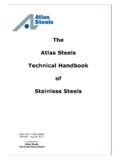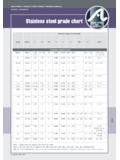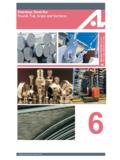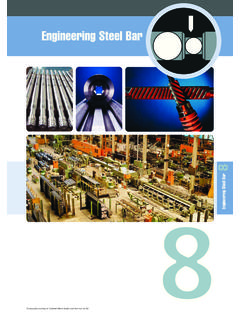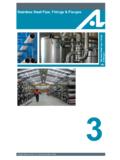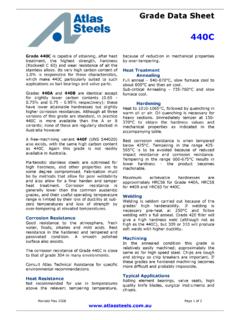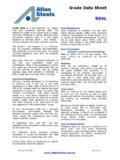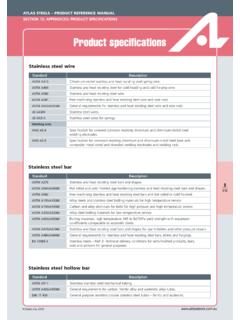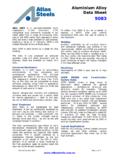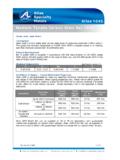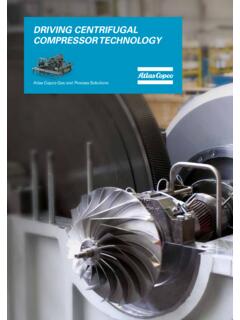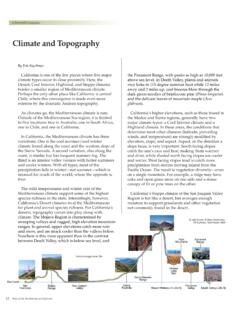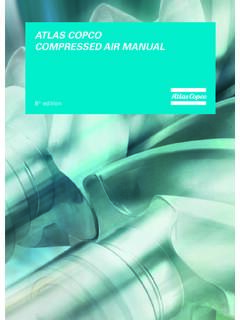Transcription of Atlas Aluminium datasheet 5083 rev Oct 2013 - Atlas Steels
1 Aluminium AlloyData Sheet5083 Revised October 2013 Page 1 of 5083is a non-heat-treatable 4 %magnesium, , alloy commonly available in flatrolled plate from a range of producing all the 5000-series high magnesium alloys5083 achieves a high strength by cold working,enabling a series of H tempers; 5083 is thehighest strength of any of these 5083 is best known as a plate for alloy is also produced as extrudedseamless tube and other extrusions and asforgings; these are available on indent ResistanceExcellent in a wide range of atmosphericenvironments, for 5083 is marine magnesium content is more than 3 %Mg, so this alloy can be susceptible to stresscorrosion cracking, which limits its applicationtemperature to below 65 C and also limits theamount of cold work to intergranular corrosion and exfoliationcorrosion tests are carried out to certify 5083for marine applications refer to the latersection on B928 and classification society TreatmentAlloy 5083 is not hardenable by heattreatment.
2 It can be significantly hardened bycold work (eg by cold rolling) and various H tempers are produced most commonly H32( Hard) or the similar strength marinetempers H116 and H321 as well as the softannealed Temper O alloy spontaneously age-softens at roomtemperature immediately after cold work butwill eventually reach a stable condition; all flatrolled mill products are supplied with stableproperties. This is usually achieved by astabilisation thermal treatment as the lastoperation which results in the H32 or H321tempers. H112 temper is strain hardened asthe final operation, again to quickly reach therequired stable temper soften Alloy 5083 it can be annealed byheatingto345 C,holduntiluniformtemperature then cool; the rate of cooling isnot weldability by all standard electricand resistance methods; gas welding is notrecommended.
3 GMAW and GTAW are preferredand widely used to produce structural welding 5083 to itself or another alloy inthe 5xxx series, the recommended filler metalis 5183. Other fillers are possible. Welding ofstrain hardened tempers will reduce strengthsin the heat affected of 5083 is poor due to its RulesASTM B209M covers a large range ofaluminiumalloysintendedforgeneralappli cations architectural, structural andlight-duty marine for example. Followingserious corrosion problems leading up to 2000the new standard ASTM B928M was introducedto prevent corrosion of ship structures. Alloy5083 and only a few other high magnesiumalloys are included in B928M.
4 The only temperspermitted H116 and H321 for 5083 requiretestingforexfoliationcorrosionand intergranular corrosion resistance, to ASTMG66 and G67. In addition Classification Society(Lloyds, DNV etc) rules are frequently called forin purchase of plate for ship certificates for 5083 H116 or H321would normally show endorsement by DNV oranother Classification ApplicationsPlate for ship building, unfired welded pressurevessels, rail and other vehicles, variousstructural applications that make use of thehigh AlloyData Sheet5083 Revised October 2013 Page 2 of PropertiesThese properties are specified for flat rolled product (plate, sheet and coil) in ASTM B209M orB928M.
5 Similar but not necessarily identical properties are specified for other products such astube and bar in their respective Specification (%)(single values are maxima except as noted) Property Specification(single values are minima except as noted)Elongation(% in 50mm)minimum for sheet or plate thicknesses shownAlloy&TemperSpecTensileStrength(MPa ) Proof(MPa)All gauges (Note 2) min125083-H116B928M305 min(1)215 min(1)105083-H321B928M305-385(1)215 min(1)10 - for H116 and H321 reduced at thickness over 40mm .. tensile strength 285 MPa min andyield strength 200 MPa specified for H116 and H321 vary slightly depending on gauge. Measurement gauge lengthalso varies.
6 Refer to ASTM B928M for specified for tempers O and H32 also vary slightly depending on sheet or plate tempers F and H112 are also possible in 5083 refer to ASTM B209M for Properties(typical values)Electrical ConductivityMS/m at 20 CAlloyDensity(kg/m3)ElasticModulus(GPa)M ean Coefficientof ThermalExpansion20-100 C( m/m/ C)ThermalConductivityat 25 C( )Equal VolumeEqual MassElectricalResistivity(n .m) Specification comparisons are approximate only. The list is intended as a comparison of functionally similarmaterialsnotas a schedule of contractual equivalents. If exact equivalents are needed original specificationsmust be Alternative AlloysAlloyWhy it might be chosen instead of 50833003 Brighter appearance required, particularly when considering treadplate.
7 Much lower (decorative) anodising finish is required and lower strength is as treadplate and lower strength is AlloyData Sheet5083 Revised October 2013 Page 3 of RadiiMinimum Bend Radius for Sheet or Plate thickness t t1t1t1t1 t1 tH3211 t1 t2t2 tRecommended minimum bending radius for sheet or plate of thickness given, at 90 to the rolling values are recommended but are not guaranteed; the minimum possible bend radius will depend onthe type of bending equipment and on the tooling and its ASTM B209M 10. Standard Specification for Aluminum and Aluminum-Alloy Sheet andPlate. ASTM B928M 09. Standard Specification for High Magnesium Aluminum-Alloy Sheet andPlate for Marine Service and Similar Environments.
8 Bushfield, H., Marine Aluminum Plate - ASTM Standard Specification B928 And The EventsLeading To Its Adoption. Aluminum Association Aluminum Standards and Data 2009 Metric SI. WTIA Technical Note 2 Successful Welding of of LiabilityThe information contained in this datasheet is not an exhaustive statement of all relevant information. It is a generalguide for customers to the products and services available from Atlas Steels and no representation is made or warrantygiven in relation to this document or the products or processes it describes.
